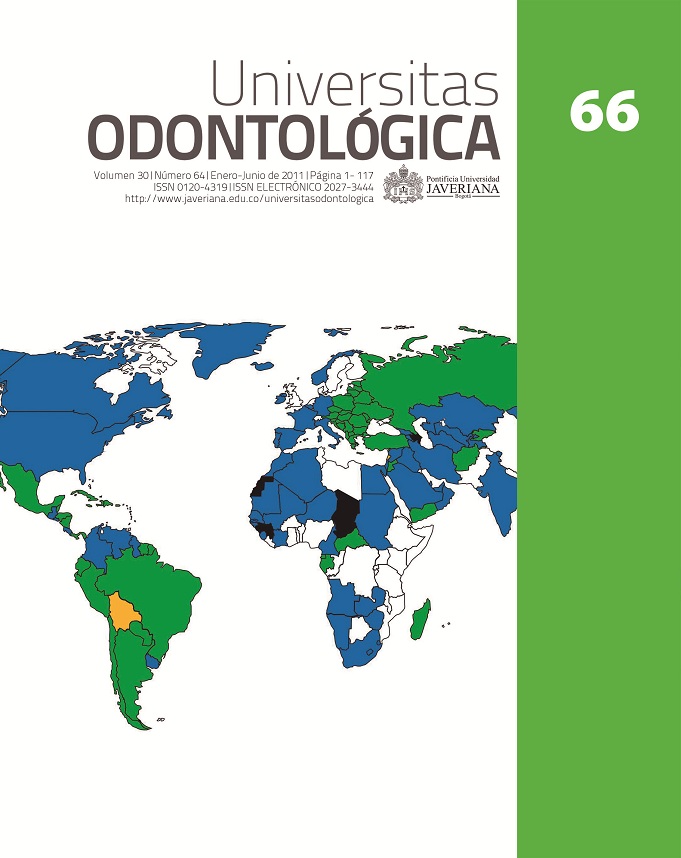Resumen
Antecedentes: los autotrasplantes dentales son una técnica que se ha utilizado durante mucho tiempo; sin embargo, son poco utilizados por las múltiples variables que determinan su éxito y la falta de unificación de criterios en la técnica. Objetivo: identificar, por medio de una revisión sistemática de la literatura, las tasas de éxito de los autotrasplantes dentales y algunos de los factores que modifican dichas tasas. Método: se realizó una búsqueda de literatura sobre autotrasplantes dentales en revistas incluidas en las bases de datos biomédicas Medline, EMBASE, CINAHL, Scisearch y PsycLIT, así como en bases de datos electrónicas con un foco específico como Cochrane Controlled Trials Register de la Cochrane Library, Health Technology Assessment y NHS-EED. Se elaboraron medidas de resumen y evaluación de la calidad metodológica mediante el programa Revman 5. Resultados: se seleccionaron veintidós artículos en los que las tasas de éxito de los autotrasplantes alcanzaron un 84 % general: 83 % en dientes con ápices cerrados, 95 % cuando se utilizó sutura con férula acrílica y 95,75 % en dientes a los que se les realizó terapia endodóntica un mes después del autotransplante. Conclusión: la literatura revisada sugiere que los autotrasplantes dentales pueden ser una alternativa para la restitución a corto, mediano y largo plazo de dientes perdidos, aunque el nivel de evidencia es III, dado que los estudios analizados son solamente de tipo descriptivo.
Background: Dental autotransplantation is a technique that has been used for a long time; however, it is not frequently used due to the many variables that determine its effectiveness and the lack of unified technical criteria. Aim: Identify, through a systematic review of literature, success rates of tooth autotransplantation and some factors that modify those rates. Method: A literature search on autologous dental transplantation was carried out in journals included in the Medline, EMBASE, CINAHL, SCISEARCH and PsycLIT biomedical databases, as well as in the Cochrane Controlled Trials Register (Cochrane Library), Health Technology Assessment and NHS-EED specialized databases. Summary measures were developed and methodological quality was assessed through the RevMan 5 software. Results: A total of 22 articles were selected. They showed 84 % general success rates of autotransplantations, 83 % in closed apex teeth, 95 % when an acrylic splint suture was used, and 95.75 % when root canal therapy was carried out one month after the transplantation. Conclusion: The literature studied suggests that dental autotransplantation may be an alternative for the restitution of tooth loss in the short-, mid-, and long-term, even though the level of evidence is III because the studies analyzed are only descriptive.
Esta revista científica se encuentra registrada bajo la licencia Creative Commons Reconocimiento 4.0 Internacional. Por lo tanto, esta obra se puede reproducir, distribuir y comunicar públicamente en formato digital, siempre que se reconozca el nombre de los autores y a la Pontificia Universidad Javeriana. Se permite citar, adaptar, transformar, autoarchivar, republicar y crear a partir del material, para cualquier finalidad (incluso comercial), siempre que se reconozca adecuadamente la autoría, se proporcione un enlace a la obra original y se indique si se han realizado cambios. La Pontificia Universidad Javeriana no retiene los derechos sobre las obras publicadas y los contenidos son responsabilidad exclusiva de los autores, quienes conservan sus derechos morales, intelectuales, de privacidad y publicidad.
El aval sobre la intervención de la obra (revisión, corrección de estilo, traducción, diagramación) y su posterior divulgación se otorga mediante una licencia de uso y no a través de una cesión de derechos, lo que representa que la revista y la Pontificia Universidad Javeriana se eximen de cualquier responsabilidad que se pueda derivar de una mala práctica ética por parte de los autores. En consecuencia de la protección brindada por la licencia de uso, la revista no se encuentra en la obligación de publicar retractaciones o modificar la información ya publicada, a no ser que la errata surja del proceso de gestión editorial. La publicación de contenidos en esta revista no representa regalías para los contribuyentes.


